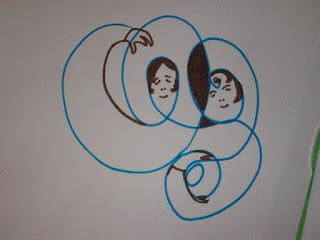 The Oxford Pocket Dictionary defines doodling as scribble or draw, esp. absentmindedly. I especially like the use of the word, absentmindedly, because if we are doing something absentmindedly or without the mind, there is a tendency to be more at ease. So, it would make sense that if the mind or for that matter, the thinking brain, is at rest and not obsessing, one could experience calm. I have not done research on the relationship between doodling and relaxation, but I tend to believe that while we doodle, our brains are resting, compared to when we are sitting around waiting nervously for a physical exam or academic test to begin.
The Oxford Pocket Dictionary defines doodling as scribble or draw, esp. absentmindedly. I especially like the use of the word, absentmindedly, because if we are doing something absentmindedly or without the mind, there is a tendency to be more at ease. So, it would make sense that if the mind or for that matter, the thinking brain, is at rest and not obsessing, one could experience calm. I have not done research on the relationship between doodling and relaxation, but I tend to believe that while we doodle, our brains are resting, compared to when we are sitting around waiting nervously for a physical exam or academic test to begin.There are a few ways to approach doodling. For instance, you can put pen, pencil or marker to paper and let them lead the way as if they have command of the page and see what happens. You can continue that process and after you have completed your doodle, look for an images that surface and color them in. That is what I did with the piece attached to this blog above. You can use color or black and white. I happen to enjoy doing this type of doodling. You can doodle with an image already in mind, but then I'm not sure it is really doodling, but none-the-less, your mind is elsewhere then on pressing issues. Doodling can be done on paper napkins, the little cardboard coffee holders, newspaper, Styrofoam cups and/or anywhere that is free for the taking. I love the fact that you really can get lost in the process of doodling and free one's mind for a few moments. I have made doodles that I've turned into larger pieces by taking the original doodle and having it enlarged at a printing store. It is endless what you can do with doodling. Next time you are feeling anxious instead of reaching for the Valium, try reaching for a pad and pencil. It might just do the trick!
Peace in Art-Making
